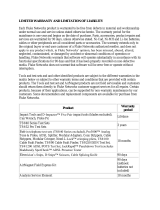
Wireless AC Clamp
Specifications
5
Specifications
Range ..................................................................... 400.0 A ac
Resolution ............................................................... 0.1 A
Accuracy
400.0 A ............................................................... 2 % ±5 digits (45 Hz to 65 Hz), 2.5 % ±5 digits (65 Hz to 400 Hz)
Inrush .................................................................. Maximum displayed reading is 999.9 A
Crest Factor (50 Hz/60 Hz) ..................................... 3 at 180 A, 2.5 at 220 A, 1.42 at 400 A, add 2 % for C.F. >2
LCD w/Backlight ...................................................... 3 ½ digits
Log Rate/Interval ..................................................... 1 second to 1 hour adjustable by PC, default, 1 minute
Battery Type ............................................................ Two AA, IEC LR6
Battery Life .............................................................. 250 hours
Memory ................................................................... Record a maximum of 65,000 readings
Radio Frequency Communications ......................... 2.4 GHz ISM Band
Radio Frequency Communication Range ............... 20 m (66 ft)
Radio Frequency Certification................................. FCC: T68-FBLE; IC: 6627A-FBLE
Operating Temperature ........................................... -10 °C to +50 °C (14 °F to 122 °F)
Storage Temperature .............................................. -40 °C to +60 °C (-40 °F to 140 °F)
Operating Humidity ................................................. 90 % at 35 °C, 75 % at 40 °C, 45 % at 50 °C
(90 % at 95 °F, 75 % at 104 °F, 45 % at 122 °F)
Operating Altitude ................................................... 2000 m
Storage Altitude ...................................................... 12 000 m
Ingress Protection ................................................... IEC 60529: IP30 (non-operating)
Safety
General ............................................................... IEC 61010-1: Pollution Degree 2
Measurement ...................................................... IEC 61010-2-032 CAT IV 300 V /
CAT III 600 V
Electromagnetic Compatibility (EMC)
International ........................................................ IEC 61326-1: Portable Electromagnetic Environment
CISPR 11: Group 1, Class A
Group 1: Equipment has intentionally generated and/or uses conductively-coupled radio frequency energy that is
necessary for the internal function of the equipment itself.
Class A: Equipment is suitable for use in all establishments other than domestic and those directly connected to a
low-voltage power supply network that supplies buildings used for domestic purposes. There may be potential
difficulties in ensuring electromagnetic compatibility in other environments due to conducted and radiated
disturbances.
Caution: This equipment is not intended for use in residential environments and may not provide adequate protection to
radio reception in such environments.
Emissions that exceed the levels required by CISPR 11 can occur when the equipment is connected to a test object.
Korea (KCC) ....................................................... Class A Equipment (Industrial Broadcasting & Communication
Equipment)
Class A: Equipment meets requirements for industrial electromagnetic wave equipment and the seller or user should
take notice of it. This equipment is intended for use in business environments and not to be used in homes.
USA (FCC) .......................................................... 47 CFR 15 subpart B. This product is considered an exempt device per
clause 15.103.
Wireless Radio
Frequency Range ............................................... 2412 MHz to 2462 MHz
Output Power ...................................................... <10 mW
Temperature Coefficient ......................................... Add 0.1 X (specified accuracy)/ °C (<18 °C or >28 °C)
Add 0.1 X (specified accuracy)/ °
F (<64.4 °F or >82.4 °F)
Size ......................................................................... 185.5 mm x 75.0 mm x 35.5 mm (7.3 in x 2.9 in x 1.4 in)
Weight ..................................................................... 0.283 kg (10 oz)
Jaw Opening ........................................................... 30.0 mm (1.2 in)



















